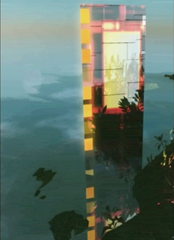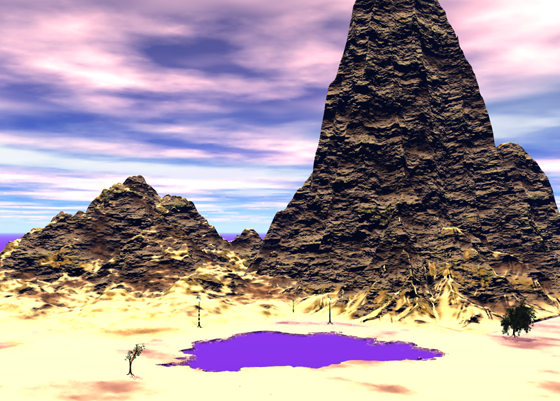Landscape rendering
 From Wikiversity - Reading time: 3 min
From Wikiversity - Reading time: 3 min
Welcome to the learning project for Landscape Rendering. Participants in this learning project experiment with available 3D computer graphics software that can render digital images that look like landscapes.
Terragen
[edit | edit source]Terragen version 0.9 for Macintosh was used to make the image shown below. This image was made according to the provided introductory instructions. The camera location and target for this image can be seen at Image:Terragen4.png. The camera height was 300 metres and the height of the camera target was 50 m. The image was rendered at 1280 x 960 pixels and took 48 minutes on a 1.42 GHz G4. The image was then processed in Photoshop to a final size of 640 x 480 pixels and the image was sharpened.

Additional reading
[edit | edit source]Activities
[edit | edit source]- Experiment with a version of Terragen such as Terragen 2 and describe your results here. If you try the Terragen 2 preview version, make use of the Help menu's link to the discussion forum and documentation.
- Explain the purpose of the FreeImage Public License.
Vue
[edit | edit source]Vue 6 for Macintosh was used to make the images shown below. The image to the left was made after watching the Kickstart tutorial. The Science Fiction/White Dwarf atmosphere was used. The highly reflective liquid option was used for the ocean. A standard terrain element was added, two planets, and two Sci-Fi plant elements. The image was rendered at 640 x 480 pixels on the Ultra quality. The rendered image was sharpened and cropped in Photoshop. Rendering took 15 minutes minutes on a 1.42 GHz G4.


For the 5 second animation example (above), the same atmosphere and liquid elements were used and a single planet. The terrain element was given the properties of the EcoSystems/Garden preset. With the island covered with vegetation, the scene has nearly 4,000,000 polygon elements. The alien building next to the island wan made from a rectangular "Alpha plane" element and given the properties of the "Futuristic building" preset from the special effects collection. The animation was rendered using the "Broadcast" setting and 122 frames. The video is 348 x 480 pixels.
Activity
[edit | edit source]Download the Vue software and install it on you computer. Do the provided Vue "Kickstart tutorial" and then experiment with creating and rendering a scene. Upload an example of you results to Wikiversity.
Bryce 5.5
[edit | edit source]
Bryce 5.5 for Macintosh was used to make the image shown to right. The manual and tutorial does not exactly match the Bryce 5.5 Macintosh distribution. The default image size was reduced 50% in Photoshop to produce the image shown here. The image took about 5 minutes to render on a 1.42 GHz G4.

In the Bryce animation example (above) the Starfield sky preset was used with no ground plane. Earth was created as a sphere but the Moon was simply a flat "billboard" object. The space ship is a simple torus.
Bryce includes a plugin module for Daz Studio, software that is specialized for posing and rendering of models of human-like characters. See: Rendering models of living organisms.
Activity
[edit | edit source]Try the Bryce 5.5 software. Note that DAZ Studio can be launched from within Bryce as a plugin component. Bring a character from DAZ Studio into Bryce and render a combination landscape and character. Upload an example of you results to Wikiversity.
See also
[edit | edit source]- Rendering models of living organisms - learning project for software for rendering and animation of human figures and other similar 3D models.
- Big and Ugly Rendering Project - distributed computing project for the rendering of 3D graphics
| Tools for creating internet content | ||||||||||||||||||||||||||||||||||||
|---|---|---|---|---|---|---|---|---|---|---|---|---|---|---|---|---|---|---|---|---|---|---|---|---|---|---|---|---|---|---|---|---|---|---|---|---|
|
Tools for image creation and manipulation
Tools for video creation and editing.
Tools for digital audio file creation and editing.
Text files
| ||||||||||||||||||||||||||||||||||||
| See also: Digital media workshop - Related discussion: Free content | ||||||||||||||||||||||||||||||||||||
 KSF
KSF